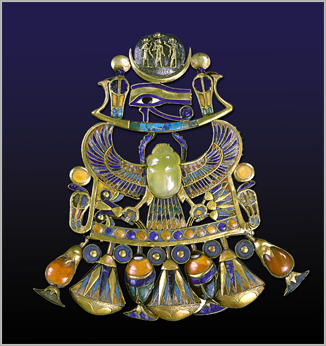Mystery surrounding strange yellow glass adornment of King Tut finally cracked
Planetary scientists have finally unraveled the 100-year-old mystery surrounding a piece of yellow glass used as a scarab centerpiece in iconic jewelry created for the ancient Egyptian pharaoh Tutankhamun.
The nearly-pure silica, canary yellow stone was used as part of King Tut’s Pectoral. The large breastplate is decorated in gold, silver and various jewels centered around the yellow, translucent gemstone.
Since the 29-million-year-old piece of glass was discovered inside King Tut’s tomb in the Egyptian desert in 1922, theories as to what it could be, or where it could have come from, have varied wildly.

British archaeologist Howard Carter, who found the stone originally, thought it a common kind of quartz. A decade later, British geographer Patrick Clayton claimed it was a piece of Libyan Desert Glass (LDG), a quartz-rich deposit of a dry lake that’s one of the rarest minerals on Earth.
READ MORE: King Tut revealed: Iconic tomb reopens after decade of restorations (PHOTOS)
In the 1990s, Italian mineralogist Vincenzo de Michele conducted his own analysis and appeared to confirm the LDG theory – that the material in question formed when a meteorite impacted and melted the quartz-rich desert sand.
The theory, however, had one flaw: no impact crater was ever found. Another study, published in 2013, claimed an ice comet may have exploded above the desert, creating a blast so hot that it melted the upper layers of the desert sand, forming the glass without leaving evidence of a crater.
Now, scientists claim to have solved the mystery once and for all. New analysis found mineral evidence from inside the glass itself that only forms during a meteorite impact, confirming the space rock had to strike Earth to create the hard yellow material.
Also on rt.com Huge haul of mummified animals uncovered at 2,000yo Egyptian tomb (PHOTOS, VIDEO)The latest study by researchers in Curtin University’s School of Earth and Planetary Sciences, and published in the journal Geology, hopes to end the decades-long debate as to whether the glass formed from an asteroid airburst or meteorite impact.
“Both meteorite impacts and airbursts can cause melting, however, only meteorite impacts create shock waves that form high-pressure minerals, so finding evidence of former reidite confirms it was created as the result of a meteorite impact,”said the lead author of the study, Dr. Aaron Cavosie.
Like this story? Share it with a friend!












